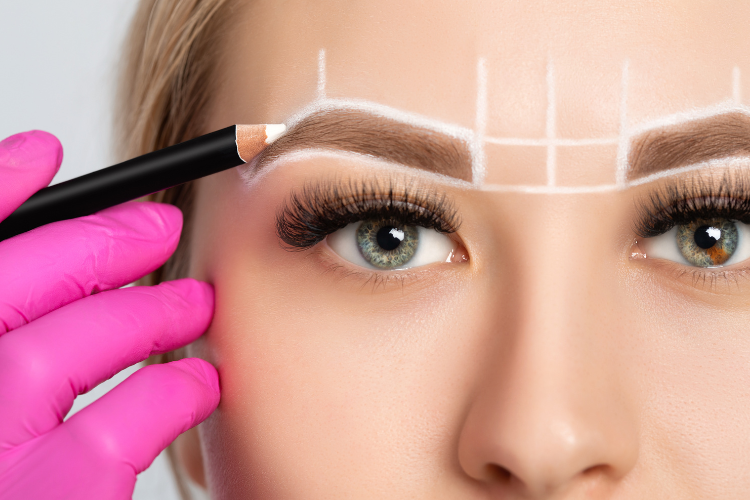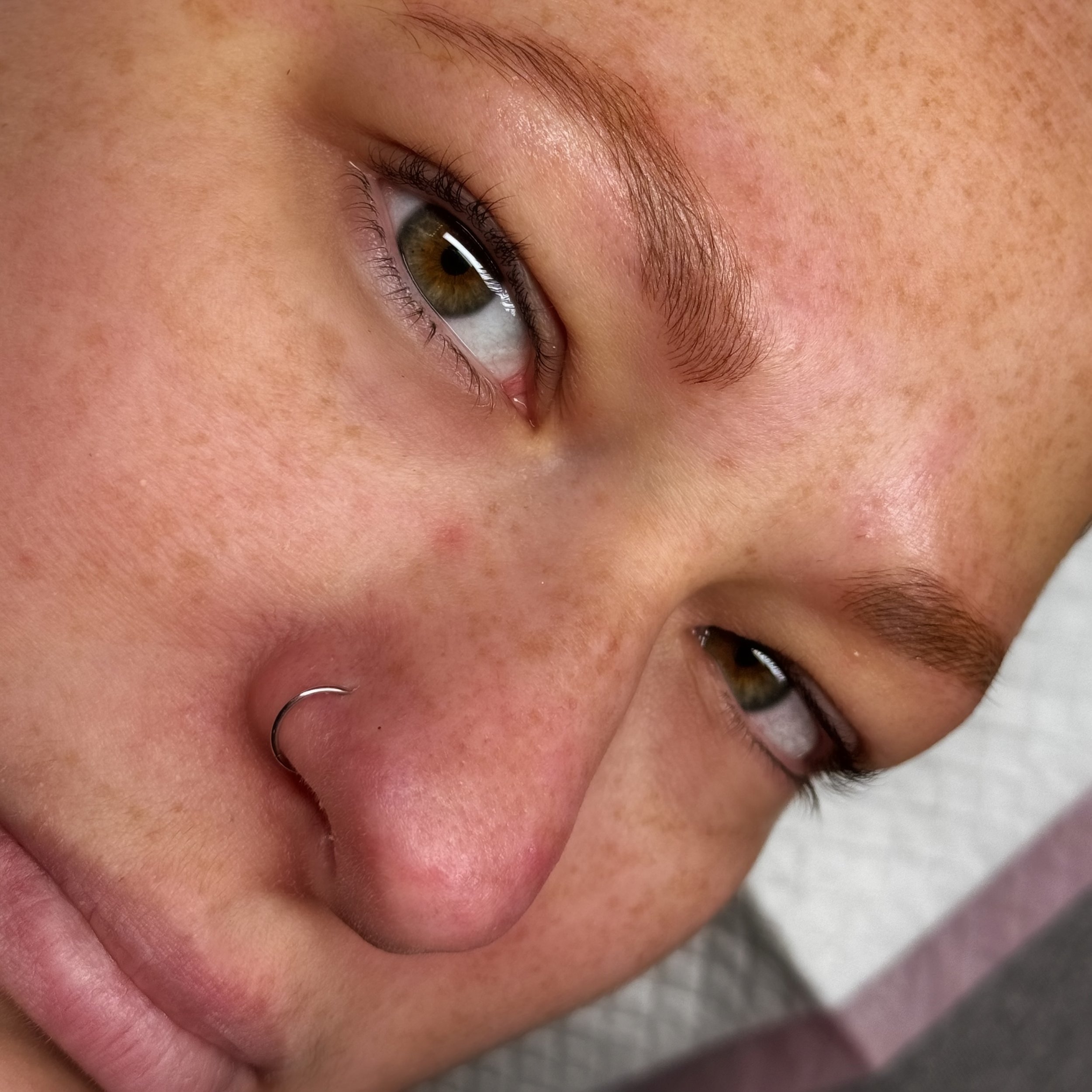PMU Microblading & Powder Brows
What is PMU?
Permanent Makeup is a semi-permanent form of Makeup Artistry using pigments and a rotary PMU machine pen. For Brows we offer a few different types of PMU. Microblading, Powder Brows and Combo Brows aka Blade and Shade.
Microblading is the process of using a very small (micro) blade and implanting PMU pigment in the form of hair strokes resulting in a natural hair like appearance.
Powder Brows are created with a rotary machine PMU pen, a needle cartridge and PMU pigment. This creates a powder like effect that resembles makeup. It can be fully customized to be natural or dramatic. It can be darker in the tail, and lighter in the fronts which is called Ombre.
Combo Brow is combining both Microblading and Powder Brows, and Combre is combining both using an Ombre technique.
How is PMU Different from Tattooing?
PMU uses a Permanent Makeup pen, which has a lower voltage and shorter needle depth. Because PMU Pens have a lower voltage, they are also not powerful enough to do large tattoo pieces, and can only really handle small fine line tattoos (aka Tiny Tattoos) which most Tattoo ARtists don’t like to do anyways. PMU pigments are designed to slowly fade, so they don’t last forever like a tattoo does and the look is much softer than a traditional tattoo.
Before Instructions for PMU Permanent Makeup
Microblading, Powder & Combo Brows
PMU is an amazing way to create dream eyebrows, however the procedure is not recommended for everyone due to contraindications. To prevent any complications to your health, and any procedure complications, please review all the information listed: the PMU requirements; contraindications; and meds to avoid prior to your appointment if your health and Doctor allow it.
Proper preparation for a PMU brow appointment will also help to achieve the best possible healed results, so be sure to prepare accordingly.
***Appointments typically last 3 hours; guests are not permitted to be present during your appointment, so please make necessary arrangements in advance for children who will need childcare. Children under the age of 18 are not permitted in the tattoo studio or unaccompanied in the shop during your appointment.
For Clients Who Have Had the Procedure Before
For all clients who have permanent cosmetic makeup procedure performed, we only use the very finest pigments available. Some procedures may need to be repeated because the original application can fade anywhere from 25% to 40%. Individual chemical and genetic makeup can affect the final result.
We Cannot Predict Your Fading Experience
It is fully possible to get the perfect results with only one application; however, this cannot be guaranteed. Please remember that the amount of pigment you retain or lose after your initial application is not a reflection of the quality of work. Pigment retention varies with each person. In case your procedure must be repeated, you will need to wait at least 21 days of the date of your original application.
Application Cannot Be Repeated Within 45 Days or Less
The tissue is not ready to absorb new pigment although your skin looks healed. Please be patient.
BEFORE MICROBLADING
Immediateley after microblading
REQUIREMENTS BEFORE PMU:
No Botox treatments should be done 3 weeks prior or 4 weeks after procedure
No chemical peels 60 days before or after procedure (brows will peel quicker due to chemicals traveling under the skin)
Do not tan or have a sunburned face the day of the procedure
No waxing or tinting 3 days before procedure
Stop taking aspirin, niacin, vitamin E, fish oil, CoQ10 and ibuprofen 48 hours before procedure
No alcohol or blood thinners 48 hours before. Check with your Doctor to ensure it is safe for you to not use blood thinners for this period of time.
Absolutely no forms of caffeine a minimum of 24 hrs before procedure. All caffeine means no TEA, COFFEE, ENERGY DRINKS AND SODA.
ABSOLUTELY NO RETINOL creams anywhere near the brow area. This includes the forehead, eye serums or face products for a minimum of 2 weeks before.
MICROBLADING CONTRAINDICATIONS
MICROBLADING IS NOT RECOMMENDED FOR ANYONE WHO IS OR HAS THE FOLLOWING:
Sick with cold, flu, or sinus/respiratory infection (please reschedule your appointment and stay home to recover)
Skin irritations including: sunburn, rash, eczema, shingles, acne, or psoriasis near the treated area
Pregnant or nursing
Under age 18 - in fact it is illegal for anyone to have a tattoo who is under the age of 18.
Had Botox within 3 weeks from scheduled appointment
Used Accutane in the past year
Diabetes
Epilepsy
Undergoing chemo
Prone to keloid scarring
Pacemaker or major heart problems
Had an organ transplant
Viral infections and or diseases
Transmittable blood disease, HIV or Hepatitis
PMU Aftercare instructions
Absorb (Day of)
After the procedure, gently blot the area with a clean tissue to absorb excess lymph fluid.
Do this every 5 minutes until the oozing has stopped.
Removing this fluid prevents hardening of the lymphatic fluids.
Wash (Days 1-7)
Wash daily to remove bacteria, build up of product and oils, and dead skin. (Don't worry, THIS DOES NOT REMOVE THE PIGMENT!)
Gently wash the area each morning and night with water and gentle soap or an unscented cleanser like Dial Soap, Cetaphil, or baby shampoo. With a very light touch, use your fingertips to gently cleanse the area.
Rub the area in a smooth motion for 10 seconds and rinse with water ensuring that all soap is rinsed away.
To dry, gently pat with a clean tissue. DO NOT use any cleansing products containing acids (glycolic, lactic, or AHA), or exfoliants.
Moisturize and hydrate (Days 1-7)
Apply a tiny, rice grain amount of the aftercare given to you 3 times a day with a cotton swab and spread it across the treated area.
Be sure not to over-apply, as this will suffocate your skin and delay healing. The product should be barely noticeable on the skin.
NEVER put the product on a wet or damp tattoo.
This should cover it, but here are some extra tips to help with a smooth and easy recovery:
Important Reminders
Use a fresh pillowcase while you sleep.
Let any scabbing or dry skin naturally exfoliate away. Picking can cause scarring or loss of color.
No facials, botox, chemical treatments or microdermabrasion for 4 weeks.
Avoid hot, sweaty exercise for one week.
Avoid direct sun exposure or tanning for 4 weeks after the procedure. Wear a hat when outdoors.
Avoid long, hot showers for the first 10 days.
Avoid sleeping on your face for the first 10 days.
Avoid face-down swimming, lakes, and hot tubs for the first 10 days,
Avoid topical makeup and sunscreen on the area.
DO NOT rub, pick, or scratch the treated area.
Important Instructions for Showering
Limit your showers to 5 minutes so that you do not create too much steam. Keep your face/procedure area out of the water while you wash your body, then, at the end of your shower, wash your hair.
Your face should only be getting wet only at the end of the shower.
Avoid excessive rinsing and hot water on the treated area.
Wet V.S. Dry Healing
This is where things get misconstrued. Many artists tell their clients not to wash the area for the entire healing time. Client’s mistake this for a “dry healing method” in actuality, this is what the different healing methods are:
The wet healing method - applying a product to the area after washing the area
The dry healing method - not applying any product to the area after washing the area.
But, what method actually promotes best healing?
The wet method of daily washing to reduce the buildup of bacteria and dead skin coupled with the application of an aftercare product allows the skin to heal fastest and so your beautiful artwork can show through.
Applying aftercare will help to produce the proper cells to regenerate the surrounding tissues. It can also help the production of collagen, a protein that is essential for the proper healing and regeneration of damaged tissue. The method consists of daily cleansing of the injured skin to prevent bacterial buildup, as well as the application of a healing ointment.






